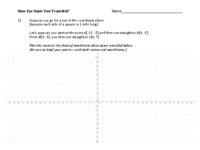
Conic Sections
Whenever a plane intersects a double-napped right-circular cone, the intersection of these 2 surfaces (cross section) is called a [b]conic section[/b]. [br][br]There are a few types of [b]conic sections[/b] (illustrated below). [br][br]Without looking up any other information on your internet browser, can you describe, in your own words, conditions that cause each conic section to form? [br][br][b]Note:[/b] [br]If the [color=#1e84cc][b]BLUE POINT[/b][/color] is [b][color=#1e84cc]LARGE[/color][/b], it is also moveable.
Locus Problem (1)
In the applet below, [br][br][i][color=#1e84cc][b]F[/b][/color][/i][color=#1e84cc][b] is a point[/b] [/color]that is not on line [i]d[/i]. [br][b]Point [i]D[/i] is a point that lies ON [color=#666666]the line that passes through [i]A [/i]and [i]B[/i][/color]. [br][/b]The [color=#ff00ff][b]pink line[/b][/color] is the [color=#ff00ff][b]perpendicular bisector[/b][/color] of the segment with endpoints [i][color=#1e84cc][b]F[/b][/color][/i] and [i][b]D[/b][/i]. [br][br]Drag [b]point [i]D[/i][/b] along the line. What do you see? Describe in detail! [br] [br]Feel free to alter the locations of [color=#666666][i][b]A,[/b][/i][/color] [i][color=#666666][b]B[/b][/color], [/i]and/or [i][color=#1e84cc][b]F[/b][/color][/i][color=#666666]. [br][/color]Then [color=#38761d][b]clear the trace[/b][/color] and drag [b]point [i]D[/i][/b] along [color=#666666][b]the line[/b][/color] again. [br][br]Why does this occur?
Please go to the [url=https://www.geogebra.org/m/sduBXC6P]Locus Construction 1 Task[/url] and begin!
Locus Problem (2)
In the applet below, [br][br][color=#1e84cc][b][i]O[/i] is the center [/b][/color]of the circle shown. [br][b]Point [i]D[/i] is a point that lies ON this circle. [/b][br][color=#1e84cc][b]Point [i]A[/i] is a point that ALWAYS LIES INSIDE[/b] [/color]the circle. (You can move it anywhere you'd like). [br]The [color=#ff00ff][b]pink line[/b][/color] is the [color=#ff00ff][b]perpendicular bisector[/b][/color] of the segment with endpoints [i]A[/i] and [i]D[/i]. [br][br]Drag [b]point [i]D[/i][/b] around the circle a few times. What do you see? Describe in detail! [br] [br]Feel free to alter the locations of [i][color=#1e84cc][b]A[/b][/color][/i] and [i][color=#1e84cc][b]R[/b][/color]. [/i]Then clear the trace and drag [b]point [i]D[/i][/b] around again. [br][br]Why does this occur?
Please go to the [url=https://www.geogebra.org/m/TZu6tRwE]Locus Construction 2 Task[/url] & begin!
Parallelogram Creation Exercises (I)
[color=#000000]In the applets below, 3 vertices of a parallelogram are shown.[br]The coordinates (x,y) of these vertices are also displayed as well. [br][br]In each task below, determine the coordinates of each parallelogram's 4th vertex. [br]Plot this point in the coordinate plane. [br]Feel free to use any of the tools of the limited toolbar when doing so. [br]Then, use the Polygon tool to construct the parallelogram.[br][br]Afterwards, use any of the tools of each applet's limited toolbar to clearly show that the quadrilateral you've constructed is indeed a parallelogram. [/color]
Rise & Run (Revamped)
[color=#9900ff][b]Link to Accompanying Lesson Activity:[/b] [/color][br][br][b][color=#0000ff][url=https://docs.google.com/document/d/1JxXYo0xWbWfqmFjScOvexHhdZ1Zmui-ju0NuXwQKSIc/edit?usp=sharing]Rise & Run: Investigation[/url] [/color][/b]
Midpoint and Endpoint Coordinates Action!
Here, point A is an endpoint and point M is a midpoint. Move A and M where you'd like and slide the slider to find the other endpoint (B).
Distance in the Coordinate Plane (With Hints)
Discovery Lesson (Can be used without interactive figure below)
Geometry Resources
[list][*][b][url=https://www.geogebra.org/m/z8nvD94T]Congruence (Volume 1)[/url][/b][/*][*][b][url=https://www.geogebra.org/m/munhXmzx]Congruence (Volume 2)[/url][/b][/*][*][b][url=https://www.geogebra.org/m/dPqv8ACE]Similarity, Right Triangles, Trigonometry[/url][/b][/*][*][b][url=https://www.geogebra.org/m/C7dutQHh]Circles[/url][/b][/*][*][b][url=https://www.geogebra.org/m/K2YbdFk8]Coordinate and Analytic Geometry[/url][/b][/*][*][b][url=https://www.geogebra.org/m/xDNjSjEK]Area, Surface Area, Volume, 3D, Cross Section[/url] [/b][/*][*][b][url=https://www.geogebra.org/m/NjmEPs3t]Proof Challenges[/url] [/b][/*][/list]
What phenomenon is dynamically being illustrated here? (Vertices are moveable.)
What phenomenon is dynamically being illustrated here? (Vertices are moveable.)
Functions Resources
[list][*][b][url=https://www.geogebra.org/m/k6Dvu9f3]Interpreting Functions[/url][/b][/*][*][b][url=https://www.geogebra.org/m/uTddJKRC]Building Functions[/url][/b][/*][*][b][url=https://www.geogebra.org/m/GMvvpwrm]Linear, Quadratic, and Exponential Functions[/url][/b][/*][*][b][url=https://www.geogebra.org/m/aWuJMDas]Trigonometric Functions[/url][/b][/*][/list]
